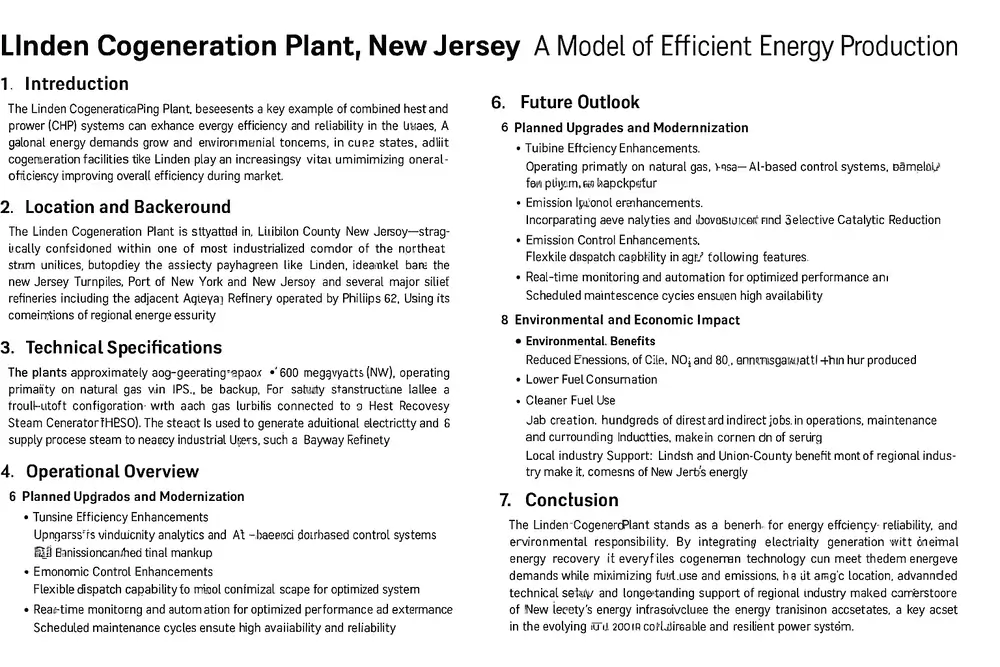The Linden Cogeneration Plant New Jersey, represents a key example of how combined heat and power (CHP) systems can enhance energy efficiency and reliability in the United States. As global energy demands grow and environmental concerns become more pressing, cogeneration facilities like Linden play an increasingly vital role in modern power infrastructure. Unlike conventional power plants that waste a significant portion of energy as heat, cogeneration plants utilize that thermal energy for industrial or district heating purposes, drastically improving overall efficiency.
This article provides a comprehensive overview of the Linden Cogeneration Plant, focusing on its location, technical specifications, operations, environmental benefits, and its strategic role in both local and regional energy markets.
Location and Background
The Linden Cogeneration Plant is situated in the city of Linden, Union County, New Jersey—strategically positioned within one of the most industrialized corridors of the northeastern United States. Its location offers close proximity to key infrastructure such as the New Jersey Turnpike, Port of New York and New Jersey, and several major oil refineries, including the adjacent Bayway Refinery operated by Phillips 66.
Commissioned in the early 1990s, the plant was initially developed to provide reliable electricity and process steam to meet the energy demands of local industries. Over the years, ownership and operational structure have evolved, often involving partnerships between private energy firms and industrial stakeholders. The plant continues to serve as a cornerstone of regional energy security and industrial productivity.
Technical Specifications
The Linden Cogeneration Plant boasts a total generation capacity of approximately 900 megawatts (MW), making it one of the largest combined heat and power (CHP) facilities on the East Coast of the United States. The plant operates primarily on natural gas as its main fuel source, with ultra-low sulfur diesel (ULSD) available as a backup for operational flexibility and reliability.
The facility comprises six gas turbines and three steam turbines, arranged in a multi-shaft configuration. Each gas turbine is coupled with a Heat Recovery Steam Generator (HRSG), allowing the plant to recover and reuse waste heat to produce high-pressure steam. This steam is then used to generate additional electricity via steam turbines and to supply process steam to nearby industrial users, such as the Bayway Refinery.
Key features include:
- Combined-cycle design for high thermal efficiency (up to ~80%)
- Dual-fuel capability to ensure reliability under varying fuel supply conditions
- Advanced emission control systems, including low-NOx burners and Selective Catalytic Reduction (SCR) units
- Black start capability, enabling grid support during outages
These specifications enable the plant to operate with a high capacity factor, rapid start-up capability, and minimal environmental impact compared to conventional fossil fuel-based generation.
📊 Technical Overview of Linden Cogeneration Plant New Jersey
| Parameter | Specification / Detail |
|---|---|
| Total Electrical Capacity | ~900 MW |
| Primary Fuel | Natural Gas |
| Backup Fuel | Ultra-Low Sulfur Diesel (ULSD) |
| Gas Turbines | 6 Units |
| Steam Turbines | 3 Units |
| Heat Recovery Steam Generators | 6 Units (One per gas turbine) |
| Plant Type | Combined Cycle Cogeneration (CHP) |
| Thermal Efficiency | Up to ~80% (with steam recovery) |
| Steam Output | Supplied to nearby industrial customers (e.g., Bayway Refinery) |
| Emission Controls | Low-NOx Burners, SCR (Selective Catalytic Reduction) |
| Black Start Capability | Yes (Supports grid in emergencies) |
| Dual-Fuel Capability | Yes |
Operational Overview
The Linden Cogeneration Plant operates as a combined heat and power (CHP) facility, delivering both electricity and steam with exceptional efficiency. The plant is connected to the PJM Interconnection, one of the largest regional transmission organizations in the United States, enabling it to supply power directly to the grid and support regional energy demand.
A key aspect of its operation is the steam delivery system. The high-pressure steam produced from recovered heat is piped to nearby industrial customers, most notably the Bayway Refinery, where it is used for various refining processes. This seamless integration between electricity and thermal energy production significantly reduces fuel consumption and environmental impact compared to separate systems.
Operational highlights include:
- Flexible dispatch capability to meet varying grid demand
- Rapid start-up and load-following features
- Real-time monitoring and automation for optimized performance
- Scheduled maintenance cycles to ensure high availability and reliability
Thanks to its cogeneration design and strategic partnerships, the Linden plant achieves a capacity factor above national averages, maintains low emissions, and plays a critical role in grid stability during peak demand or unexpected outages.

Environmental and Economic Impact
The Linden Cogeneration Plant has had a significant positive impact on both the environment and the regional economy. By utilizing a combined heat and power (CHP) system, the facility dramatically increases energy efficiency and reduces greenhouse gas emissions compared to conventional separate heat and power systems.
🌱 Environmental Benefits
- Reduced Emissions: The plant’s high efficiency translates to lower CO₂, NOₓ, and SO₂ emissions per megawatt-hour produced.
- Lower Fuel Consumption: By capturing and reusing waste heat, less fuel is required overall to produce the same amount of usable energy.
- Cleaner Fuel Use: Operating primarily on natural gas, the plant avoids the higher emissions associated with coal or oil-based generation.
💼 Economic Contributions
- Job Creation: The plant supports hundreds of direct and indirect jobs in operations, maintenance, and surrounding industries.
- Local Industry Support: Continuous steam delivery enables energy-intensive operations like the Bayway Refinery to function efficiently, reducing production costs.
- Tax Revenue: Linden and Union County benefit from substantial property tax contributions and economic activity generated by the plant.
- Grid Reliability Savings: Its ability to provide consistent base-load power and grid stability helps avoid the costs of blackouts and peaking power purchases.
In alignment with New Jersey’s Clean Energy Master Plan, the Linden facility continues to demonstrate how industrial-scale cogeneration can contribute to both sustainability goals and regional economic resilience.
Linden Cogeneration Plant – Future Outlook
As the energy sector evolves toward cleaner and more resilient systems, the Linden Cogeneration Plant is well-positioned to adapt and continue playing a critical role in the region’s power infrastructure. Several opportunities and challenges shape its future trajectory.
🔧 Planned Upgrades and Modernization
- Turbine Efficiency Enhancements: Upgrades to gas and steam turbines could increase output and reduce fuel use.
- Control System Improvements: Incorporating advanced analytics and AI-based control systems may enhance operational flexibility and predictive maintenance.
- Emission Control Enhancements: Investment in even more efficient SCR systems or carbon capture solutions may further reduce environmental impact.
⚡ Integration with Renewable Energy
- Hydrogen Readiness: The plant could potentially adapt its turbines to run on a blend of natural gas and hydrogen, aligning with decarbonization goals.
- Energy Storage Options: Future integration with battery storage systems could help stabilize output during variable demand or renewable intermittency.
⚖️ Regulatory and Market Challenges
- Carbon Pricing and Policy Shifts: New Jersey’s evolving energy regulations may affect operational costs and investment planning.
- Competition from Renewables: While cogeneration is efficient, the increasing share of low-cost solar and wind energy could challenge traditional CHP economics.
Despite these factors, the Linden Cogeneration Plant is expected to remain a vital transitional asset—bridging today’s fossil-fuel-dependent systems with the cleaner, smarter grid of tomorrow.
Linden Cogeneration Plant New Jersey Conclusion
The Linden Cogeneration Plant stands as a benchmark for industrial-scale energy efficiency, reliability, and environmental responsibility. By integrating electricity generation with thermal energy recovery, the plant exemplifies how cogeneration technology can meet modern energy demands while minimizing fuel use and emissions.
Its strategic location, advanced technical setup, and long-standing support of regional industry make it a cornerstone of New Jersey’s energy infrastructure. As the energy transition accelerates, Linden’s adaptability—through potential upgrades, hydrogen integration, and grid support capabilities—positions it as a key asset in the movement toward a more sustainable and resilient power system.
In a time when both energy efficiency and environmental stewardship are imperative, the Linden Cogeneration Plant serves as a model for how legacy infrastructure can evolve to meet the challenges of the 21st century energy landscape.










